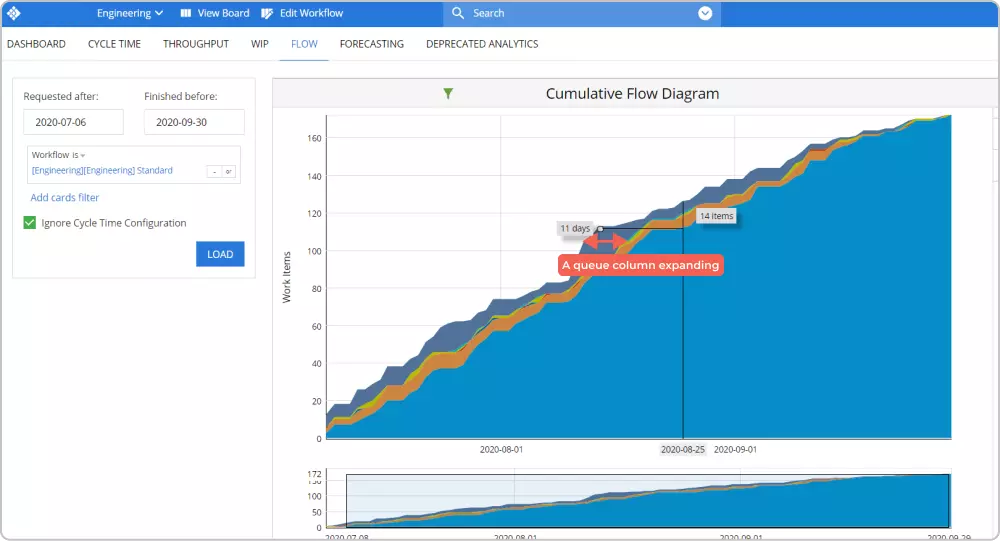Variation is part of everyday work. Whether we're commuting, writing reports, or delivering software, no two instances are exactly the same. This natural variability may seem harmless, but when left unmanaged, it can undermine quality, increase delivery time, and frustrate customers.
That's why, especially in project and service environments, understanding and addressing process variation is essential for performance and predictability.
Why Is Process Variation a Problem for Quality and Performance?
Imagine two developers working on the same task. One finishes in 2 hours, the other in 5. Differences in skill, tools, or complexity cause this variation. Now multiply it across teams, days, and dozens of tasks — and you'll see how easily it can lead to missed deadlines, overloaded queues, wasted effort, and unpredictable outcomes.
Here are some common areas where variation causes friction:
- Delivery time
- Quality of results
- Team workload
- Customer satisfaction
What's more, in many service processes, most of the elapsed time is not actual work but waiting time. For instance, a patient may spend only 15 minutes with a doctor, but the full visit spans 6 hours. That means 96% of the time is waiting — and that's where variation hides.
Understanding the Effects of Variation
To see how variation impacts your organization, it helps to think in terms of a simple queuing system:
A customer arrives, waits if the service can't start immediately, and leaves once served. Or a requirement comes in, waits for development to begin, and is delivered when completed.
One of the key principles in understanding delays in this system is Kingman's Formula, which connects:
- Variation in arrival rate (how unpredictably work arrives)
- Resource utilization (how busy your team is)
- Effective processing time (how long each task takes)
Average Waiting Time = f (Arrival Variation, Resource Utilization,
Effective Process time)
Two Key Effects of Process Variation
| Effect | Description |
| Single Curve Analysis | When resource utilization is close to 100%, even a slight increase in workload causes an exponential rise in job completion time. |
| Comparison of Two Curves | With the same level of resource utilization, higher process variation results in longer job completion times. |
What Tools Can You Use to Monitor Process Variation?
To manage variation, it's crucial to make it visible. Two helpful visual tools for doing this are:
Using Cumulative Flow Diagrams to Spot Variation
A Cumulative Flow Diagram (CFD) shows the flow of work through different process stages — like "To Do," "In Progress," and "Done" — over time.
When variation increases, the bands in the diagram start to diverge, signaling that work is accumulating or stalling at certain stages. The wider the "In Progress" band, the more work is stuck there — often due to bottlenecks or overloaded resources.
Boa Vista, a leading Brazilian financial solutions provider, used CFDs to track how work flowed through their teams. By regularly reviewing the diagrams, they could detect bottlenecks and flow interruptions early, whether due to bugs, dependencies, or internal delays. This allowed them to address delivery slowdowns and improve team performance proactively.
This is a practical way to observe the real-time effects of variation described by Kingman's formula, especially in high-utilization environments.
 A Cumulative Flow Diagram in Businessmap showing a widening band and indicating rising variability and longer cycle times of a process phase
A Cumulative Flow Diagram in Businessmap showing a widening band and indicating rising variability and longer cycle times of a process phase
»» Read the full Boa Vista case study
Visualizing Cycle Time Spread
Another helpful tool is the Cycle Time Scatterplot. It shows each completed work item's cycle time plotted across time, helping you spot variation trends, outliers, and predictability.
If the dots are tightly clustered, your process is consistent. But if they're scattered widely or show spikes, that's a sign of high variation — possibly caused by blocked work, unclear priorities, or irregular workloads.
AK Gida, Turkey's largest dairy producer (part of Group Lactalis), used scatterplots in their IT department to measure process performance. By analyzing how long it took for 85% or 95% of tasks to be completed, they set realistic Service Level Expectations (SLEs) — helping align delivery with stakeholder expectations.
It's a simple but powerful way to see whether work completion time is stable or erratic over time.
 A Cycle Time Scatter plot in Businessmap showing probabilities of how long it takes for 85% or 95% of the items to flow through the process
A Cycle Time Scatter plot in Businessmap showing probabilities of how long it takes for 85% or 95% of the items to flow through the process
»» Read the full AK Gida case study
How to Identify Process Variation
Start by observing common contributors:
1. Resources
- Different skill levels
- Errors or defects that cause rework
- Task handoffs between people
2. Process Complexity
- Complex requests take longer to resolve
- Different tools have different setups and response times
3. External Factors
- Time of day (e.g., printer support calls peak during business hours)
- Availability of information or team members
How to Reduce Sources of Process Variation
Once you've identified the causes, there are several ways to reduce variation:
- Improve documentation to reduce incidents
- Train teams to handle tasks more effectively
- Automate repetitive activities
- Break large tasks into smaller, manageable ones
- Streamline workflows by removing bottlenecks
- Reuse proven solutions wherever it makes sense
Ask yourself regularly: What's taking too long? Why? Can we eliminate or smooth it?
Which Lessons Are Most Valuable for Project and Service Managers?
If your team is always at 100% capacity, even small increases in workload can cause massive delays.
- Lowering resource utilization (~50–70%) gives you more flexibility and stability.
- Breaking big tasks into smaller, faster-to-complete pieces reduces queue times.
- Reducing arrival variation helps make workloads more predictable.
- Reducing waste (rework, errors, bottlenecks) has a bigger impact than shaving a few minutes off task duration.
Is Variation Always a Bad Thing?
Not at all. While excessive variation disrupts delivery, zero variation can limit innovation. If every team did the same thing the same way every time, we'd never improve.
As Henry Ford famously said, "If I had asked people what they wanted, they would have said faster horses." Apple didn't create the iPhone by reducing variation — they embraced it strategically.
The goal is to manage variation wisely:
Reduce it where predictability matters. Allow it where innovation grows.
Businessmap is the most flexible solution for aligning goals, tracking progress, and gaining full visibility across teams and portfolios — all in one place.

Teodora Bozheva
Professional Services Director at Businessmap
Teodora Bozheva is a leading expert in project management and enterprise agility and Managing Director of Businessmap Spain. Teodora is the author of the Kanban Project, Program, and Portfolio Management model and co-author of the Kanban Maturity Model. She has 18+ years of expertise in improving work ways and process efficiency in companies like BBVA-Spain, ULMA Handling Systems, Linea Directa.



